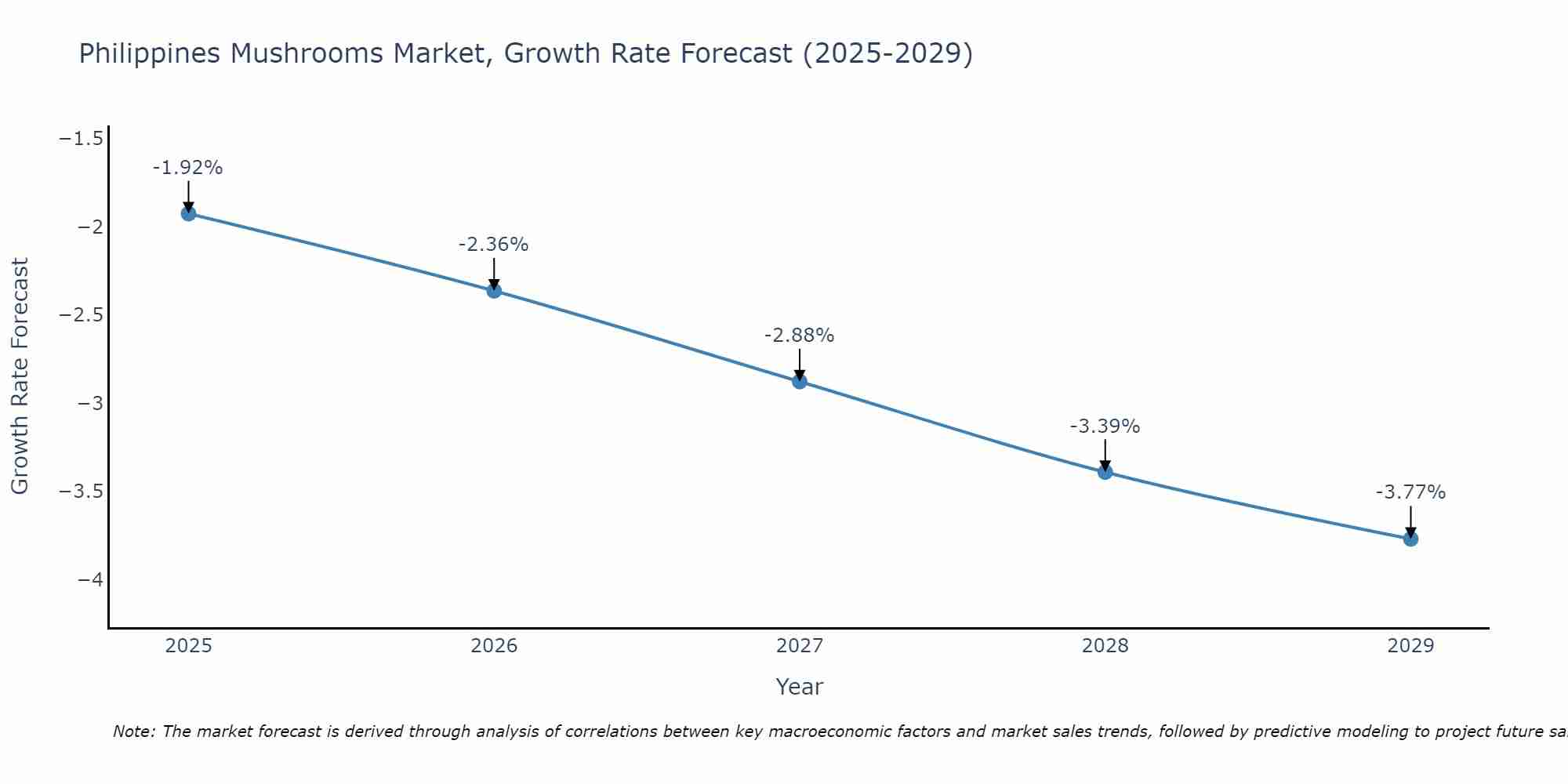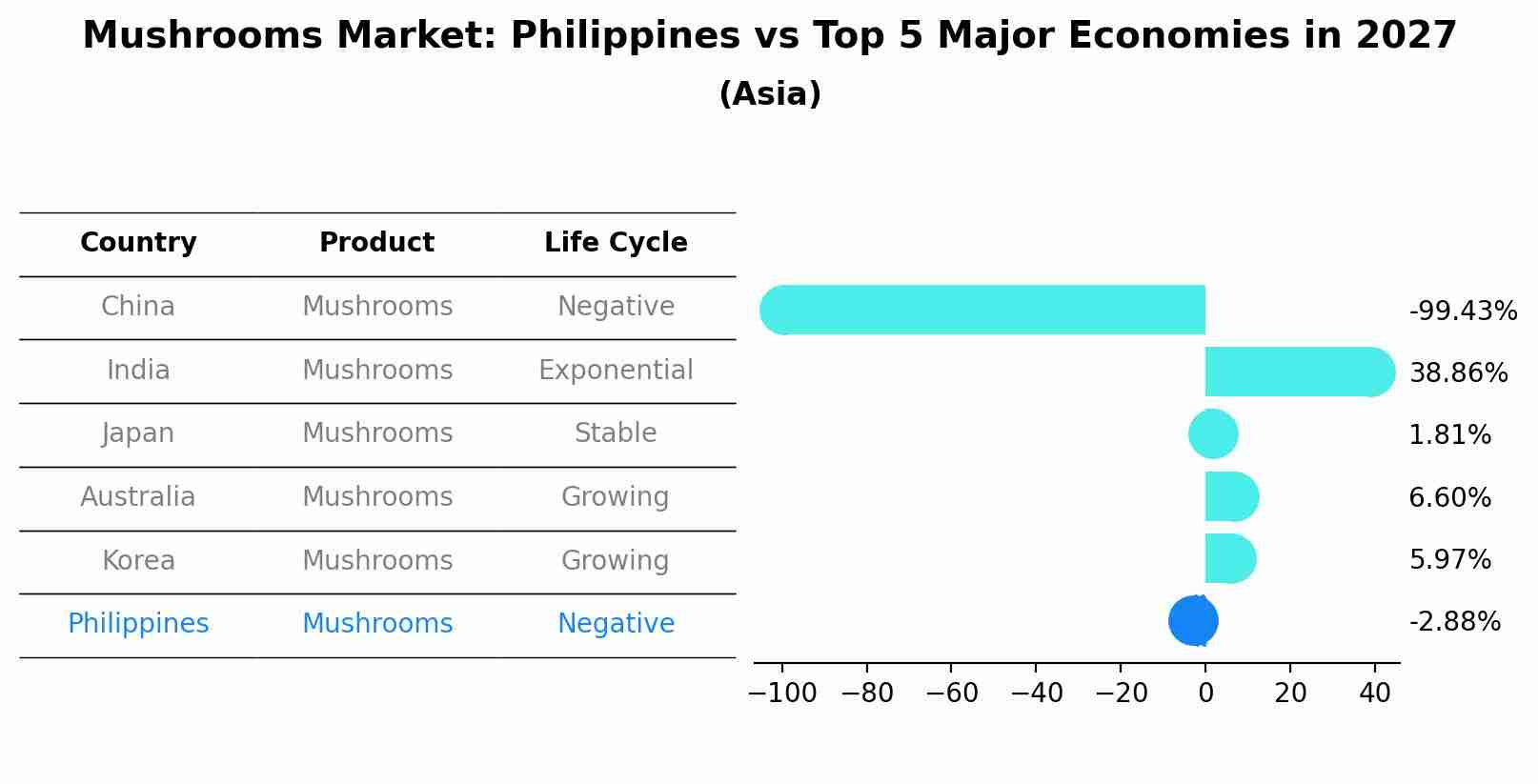Philippines Mushrooms Market (2025-2031) Outlook | Trends, Growth, Industry, Revenue, Forecast, Size, Companies, Analysis, Value & Share
| Product Code: ETC383189 | Publication Date: Aug 2022 | Updated Date: Apr 2025 | Product Type: Market Research Report | |
| Publisher: 6Wresearch | No. of Pages: 75 | No. of Figures: 35 | No. of Tables: 20 | |
Philippines Mushrooms Market Size Growth Rate
The Philippines Mushrooms Market may undergo a gradual slowdown in growth rates between 2025 and 2029. Although the growth rate starts strong at -1.92% in 2025, it steadily loses momentum, ending at -3.77% by 2029.

Mushrooms Market: Philippines vs Top 5 Major Economies in 2027 (Asia)
The Mushrooms market in Philippines is projected to grow at a negative growth rate of -2.88% by 2027, within the Asia region led by China, along with other countries like India, Japan, Australia and South Korea, collectively shaping a dynamic and evolving market environment driven by innovation and increasing adoption of emerging technologies.

philippines mushrooms market Synopsis
The Philippines hosts a diverse range of markets, each offering unique products catering to various consumer preferences. The mushroom market in the country has been steadily growing, fueled by increasing awareness of its nutritional benefits and culinary versatility. This market presents opportunities for both cultivation and wild harvesting of mushrooms.
Drivers of the Market
The Philippines mushrooms market is experiencing significant growth driven by various factors. Consumers are increasingly recognizing the nutritional and health benefits of mushrooms, which are rich in vitamins, minerals, and antioxidants. Additionally, the growing interest in plant-based diets has boosted the demand for mushrooms as a meat substitute. The local culinary scene has also embraced mushrooms, leading to an increased use in restaurants and households. As the country focuses on agricultural diversification, mushrooms present a viable and sustainable option due to their relatively low space and resource requirements. Moreover, the cultivation of mushrooms can provide economic opportunities for rural communities, contributing to employment and income generation.
Challenges of the Market
The Philippines mushrooms market faces challenges related to consumer awareness and cultural preferences. While mushrooms offer nutritional benefits and versatility in culinary applications, there might be limited awareness about the different types of edible mushrooms and their health benefits. Additionally, cultural preferences and traditional diets may not heavily incorporate mushrooms, leading to a potential obstacle in expanding the market. Ensuring consistent quality, addressing concerns about wild vs. cultivated mushrooms, and overcoming misconceptions are challenges that stakeholders need to address to promote the growth of the mushrooms market.
COVID-19 Impact on the Market
The Philippines mushrooms market experienced mixed impacts due to the COVID-19 pandemic. While there was increased interest in nutritious and immune-boosting foods like mushrooms, the market faced disruptions in terms of supply chain challenges, labor shortages, and reduced consumer spending. The closure of restaurants, hotels, and other food service establishments limited the market`s access to these distribution channels. However, the shift towards home cooking and healthy eating supported retail sales of mushrooms. Additionally, some mushroom farms faced difficulties in sourcing inputs and transporting products, leading to temporary production declines.
Key Players in the Market
The mushrooms market includes both cultivated and wild varieties. Key players might be local farmers and suppliers who distribute mushrooms to local markets and restaurants.
Key Highlights of the Report:
- Philippines Mushrooms Market Outlook
- Market Size of Philippines Mushrooms Market, 2024
- Forecast of Philippines Mushrooms Market, 2031
- Historical Data and Forecast of Philippines Mushrooms Revenues & Volume for the Period 2021-2031
- Philippines Mushrooms Market Trend Evolution
- Philippines Mushrooms Market Drivers and Challenges
- Philippines Mushrooms Price Trends
- Philippines Mushrooms Porter's Five Forces
- Philippines Mushrooms Industry Life Cycle
- Historical Data and Forecast of Philippines Mushrooms Market Revenues & Volume By Product for the Period 2021-2031
- Historical Data and Forecast of Philippines Mushrooms Market Revenues & Volume By Button for the Period 2021-2031
- Historical Data and Forecast of Philippines Mushrooms Market Revenues & Volume By Shiitake for the Period 2021-2031
- Historical Data and Forecast of Philippines Mushrooms Market Revenues & Volume By Oyster for the Period 2021-2031
- Historical Data and Forecast of Philippines Mushrooms Market Revenues & Volume By Matsutake for the Period 2021-2031
- Historical Data and Forecast of Philippines Mushrooms Market Revenues & Volume By Truffles for the Period 2021-2031
- Historical Data and Forecast of Philippines Mushrooms Market Revenues & Volume By Other for the Period 2021-2031
- Historical Data and Forecast of Philippines Mushrooms Market Revenues & Volume By Form for the Period 2021-2031
- Historical Data and Forecast of Philippines Mushrooms Market Revenues & Volume By Fresh for the Period 2021-2031
- Historical Data and Forecast of Philippines Mushrooms Market Revenues & Volume By Processed for the Period 2021-2031
- Historical Data and Forecast of Philippines Mushrooms Market Revenues & Volume By Distribution Channel for the Period 2021-2031
- Historical Data and Forecast of Philippines Mushrooms Market Revenues & Volume By Direct to Customer for the Period 2021-2031
- Historical Data and Forecast of Philippines Mushrooms Market Revenues & Volume By Grocery Stores for the Period 2021-2031
- Historical Data and Forecast of Philippines Mushrooms Market Revenues & Volume By Supermarkets & Hypermarkets for the Period 2021-2031
- Historical Data and Forecast of Philippines Mushrooms Market Revenues & Volume By Convenience Stores for the Period 2021-2031
- Historical Data and Forecast of Philippines Mushrooms Market Revenues & Volume By Online Stores for the Period 2021-2031
- Historical Data and Forecast of Philippines Mushrooms Market Revenues & Volume By Application for the Period 2021-2031
- Historical Data and Forecast of Philippines Mushrooms Market Revenues & Volume By Food for the Period 2021-2031
- Historical Data and Forecast of Philippines Mushrooms Market Revenues & Volume By Pharmaceutical for the Period 2021-2031
- Historical Data and Forecast of Philippines Mushrooms Market Revenues & Volume By Cosmetics for the Period 2021-2031
- Philippines Mushrooms Import Export Trade Statistics
- Market Opportunity Assessment By Product
- Market Opportunity Assessment By Form
- Market Opportunity Assessment By Distribution Channel
- Market Opportunity Assessment By Application
- Philippines Mushrooms Top Companies Market Share
- Philippines Mushrooms Competitive Benchmarking By Technical and Operational Parameters
- Philippines Mushrooms Company Profiles
- Philippines Mushrooms Key Strategic Recommendations
Frequently Asked Questions About the Market Study (FAQs):
- Single User License$ 1,995
- Department License$ 2,400
- Site License$ 3,120
- Global License$ 3,795
Search
Related Reports
- Australia IT Asset Disposal Market (2025-2031) | Strategy, Consumer Insights, Analysis, Investment Trends, Opportunities, Growth, Size, Share, Industry, Revenue, Segments, Value, Segmentation, Supply, Forecast, Restraints, Outlook, Competition, Drivers, Trends, Demand, Pricing Analysis, Competitive, Strategic Insights, Companies, Challenges
- UAE Building Thermal Insulation Market Outlook (2025-2031) | Revenue, Companies, Share, Trends, Growth, Size, Forecast, Industry, Analysis & Value
- Portugal Electronic Document Management Market (2025-2031) | Strategy, Consumer Insights, Analysis, Investment Trends, Opportunities, Growth, Size, Share, Industry, Revenue, Segments, Value, Segmentation, Supply, Forecast, Restraints, Outlook, Competition, Drivers, Trends, Demand, Pricing Analysis, Competitive, Strategic Insights, Companies, Challenges
- France Electronic Document Management Market (2025-2031) | Strategy, Consumer Insights, Analysis, Investment Trends, Opportunities, Growth, Size, Share, Industry, Revenue, Segments, Value, Segmentation, Supply, Forecast, Restraints, Outlook, Competition, Drivers, Trends, Demand, Pricing Analysis, Competitive, Strategic Insights, Companies, Challenges
- Portugal Occupational Health & Safety Services Market (2025-2031) | Strategy, Consumer Insights, Analysis, Investment Trends, Opportunities, Growth, Size, Share, Industry, Revenue, Segments, Value, Segmentation, Supply, Forecast, Restraints, Outlook, Competition, Drivers, Trends, Demand, Pricing Analysis, Competitive, Strategic Insights, Companies, Challenges
- Netherlands Occupational Health and Safety Services Market (2025-2031) | Strategy, Consumer Insights, Analysis, Investment Trends, Opportunities, Growth, Size, Share, Industry, Revenue, Segments, Value, Segmentation, Supply, Forecast, Restraints, Outlook, Competition, Drivers, Trends, Demand, Pricing Analysis, Competitive, Strategic Insights, Companies, Challenges
- Belgium and Luxembourg Facility Management Market (2025-2031) | Strategy, Consumer Insights, Analysis, Investment Trends, Opportunities, Growth, Size, Share, Industry, Revenue, Segments, Value, Segmentation, Supply, Forecast, Restraints, Outlook, Competition, Drivers, Trends, Demand, Pricing Analysis, Competitive, Strategic Insights, Companies, Challenges
- Russia Women Intimate Apparel Market (2025-2031) | Strategy, Consumer Insights, Analysis, Investment Trends, Opportunities, Growth, Size, Share, Industry, Revenue, Segments, Value, Segmentation, Supply, Forecast, Restraints, Outlook, Competition, Drivers, Trends, Demand, Pricing Analysis, Competitive, Strategic Insights, Companies, Challenges
- Africa Chocolate Market (2025-2031) | Size, Share, Trends, Growth, Revenue, Analysis, Forecast, industry & Outlook
- Global Hydroxychloroquine And Chloroquine Market (2025-2031) | Industry, Trends, Size, Outlook, Growth, Value, Companies, Revenue, Analysis, Share, Forecast
Industry Events and Analyst Meet
Our Clients
Whitepaper
- Middle East & Africa Commercial Security Market Click here to view more.
- Middle East & Africa Fire Safety Systems & Equipment Market Click here to view more.
- GCC Drone Market Click here to view more.
- Middle East Lighting Fixture Market Click here to view more.
- GCC Physical & Perimeter Security Market Click here to view more.
6WResearch In News
- Doha a strategic location for EV manufacturing hub: IPA Qatar
- Demand for luxury TVs surging in the GCC, says Samsung
- Empowering Growth: The Thriving Journey of Bangladesh’s Cable Industry
- Demand for luxury TVs surging in the GCC, says Samsung
- Video call with a traditional healer? Once unthinkable, it’s now common in South Africa
- Intelligent Buildings To Smooth GCC’s Path To Net Zero













